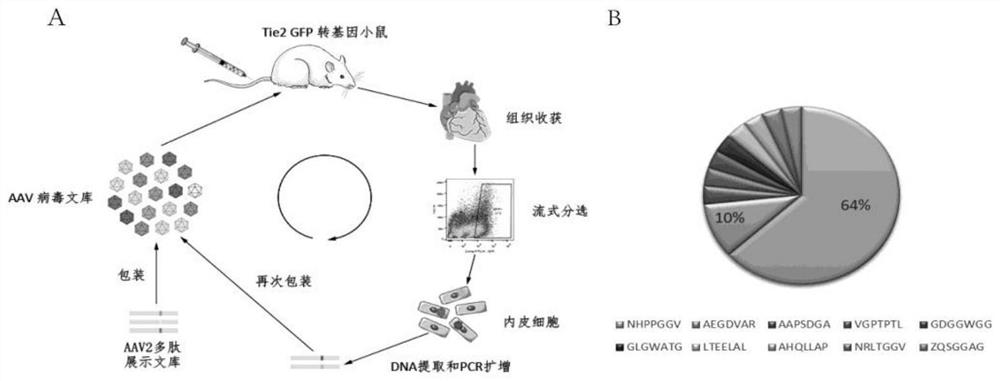Adeno-associated virus vector targeting cardiac vascular endothelium and its application
A cardiovascular and viral carrier technology, applied in the direction of virus/bacteriophage, virus, application, etc., can solve problems that have not been used, optimize cardiovascular endothelial transduction, etc., and achieve the effect of enhanced activity
- Summary
- Abstract
- Description
- Claims
- Application Information
AI Technical Summary
Problems solved by technology
Method used
Image
Examples
Embodiment 1
[0040] Example 1 In vivo directed evolution process and screening results
[0041] (1) In order to insert a random heptapeptide into the R588 site of the AAV2 capsid protein gene to construct a polypeptide display library, it is first necessary to use PCR to introduce a stuffer sequence at the R588 site and mutate the relevant sites. The primers are as follows:
[0042] 588-For:5`- GGCCCAGGCGGCC -ACCGCAGATGTCAACACACAAGGC-3`; (SEQ ID NO: 7)
[0043] 588-Rev:5`- TTGGCCTCTCTG - GCCTCTCTGGAGGTTGGTAGATAC-3`; (SEQ ID NO: 8)
[0044] Amp-1: 5`-CGTTGTCAGAAGTAAGTTGGCCGCA-3`; (SEQ ID NO: 9)
[0045] Amp-2: 5`-ATCGGAGGACCGAAGGAGCTAACCG-3`; (SEQ ID NO: 10)
[0046] Underscores are inserted padding sequences. Using the XX2 plasmid (from the University of North Carolina, USA) as a template, the 588-For and Amp-1 primers amplified a 3.1kb fragment, and the 588-Rev and Amp-2 primers amplified a 5.3kb fragment. The fragment amplified by 588-For / Amp-1 was treated with T4 polynucleotide ...
Embodiment 2
[0062] Example 2 Verification of the ability of EC71 and EC73 to transduce cardiac endothelial cells
[0063] The calcium phosphate method was used to transfect 293 cells to produce EC71, EC73, AAV1, and AAV2-Flt1-luc recombinant viruses, in which Flt1 is a promoter specifically expressed in endothelial cells, and luc is a luciferase reporter gene. The virus production process is as follows:
[0064] Passage 293 cells to a 15cm cell culture dish at a ratio of 1:3. After 24 hours, the cell density is about 80%. Add the adenovirus Phelper plasmid, packaging plasmid and recombinant AAV plasmid to 0.25M CaCl at a ratio of 4:1:3. 2 In total, 50μg plasmid and 2ml CaCl are needed per dish of cells 2 , and then the plasmid-CaCl 2 The mixture was added dropwise into an equal volume of 2×HBS for transfection of 293 cells. Change the medium after 8 hours, harvest 30 dishes of cells after 56 hours, centrifuge at 2500rpm for 10min, resuspend the pellet in 10ml DMEM for cesium chloride d...
Embodiment 3
[0068] Example 3 Transduction of EC71 and EC73 to vascular endothelium in mice
[0069] With EC71 in embodiment 2, EC73, AAV1-Flt1-luc recombinant virus is injected 3 * 10 with tail vein 11 The vector copy number reached 7-week-old male C57BL / 6 mice, and a group of mice were sacrificed at 1 week, 2 weeks, 1 month, 2 months, and 4 months, and the hearts, livers, and Luciferase activity was detected in four tissues, brain and lung. The result is as Image 6 As shown, in the heart, the three viruses can maintain transgene expression for at least 4 months, and the expression levels gradually increase, and always maintain EC71>EC73>AAV1; The expression levels of EC71 and EC73 in the liver remained at a very low level; in the brain, the three viruses were stably expressed within 4 months; gradually increased before, and then decreased. Therefore, EC71 and EC73 are able to maintain more efficient and stable transgene expression in the cardiac vascular endothelium, which may achie...
PUM
 Login to View More
Login to View More Abstract
Description
Claims
Application Information
 Login to View More
Login to View More - R&D
- Intellectual Property
- Life Sciences
- Materials
- Tech Scout
- Unparalleled Data Quality
- Higher Quality Content
- 60% Fewer Hallucinations
Browse by: Latest US Patents, China's latest patents, Technical Efficacy Thesaurus, Application Domain, Technology Topic, Popular Technical Reports.
© 2025 PatSnap. All rights reserved.Legal|Privacy policy|Modern Slavery Act Transparency Statement|Sitemap|About US| Contact US: help@patsnap.com



